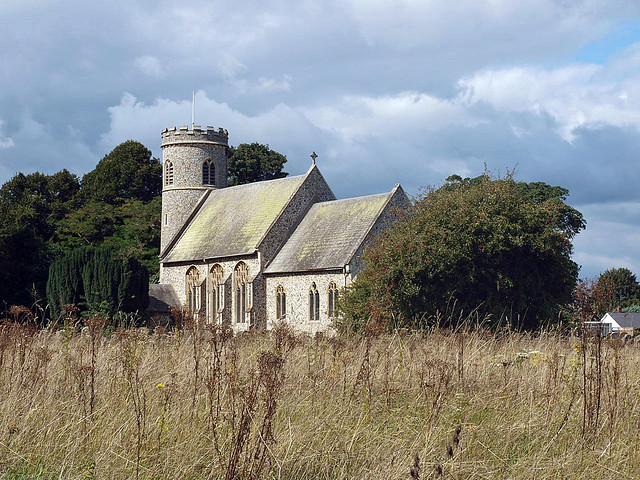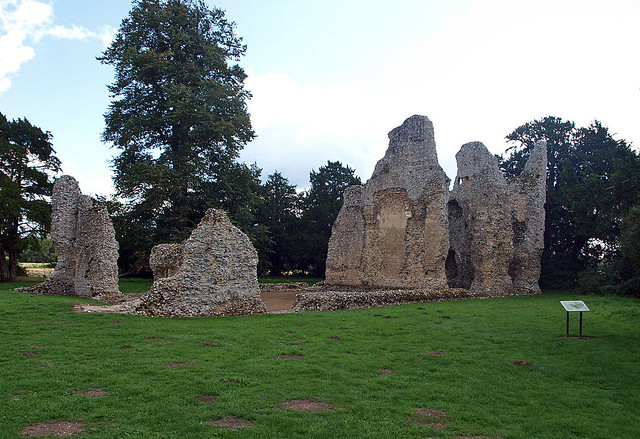ST MARY. Round tower, evidently rebuilt in the C19. Dec chancel and Dec N arcade. The former has a fine five-light E window with reticulated tracery broken into at the top by an octofoiled circle; niches inside to its l. and r. A similar simpler blocked N window. The N arcade is of four bays with piers with four main and four subsidiary shafts. In the nave Perp S windows with stepped embattled transoms. - BENCH ENDS. A number of old ones with poppy-heads. - PLATE. Two Elizabethan Cups and Paten, probably the cover for one of them; Paten, 1674-5.
WEETING CASTLE. Under the Ministry of Works, but not yet explored. The main range, probably of the late C12, consisted of a hall with two flanking additions. One of them is a substantial three-storeyed keep-like tower with an important first-floor chamber. Square moat, and apparently no curtain wall (S. E. Rigold).
WEETING. It has the old flint town of Brandon for its neighbour, and fitting it is that it should be so, for it is a very ancient place. Here on the heathland are many milestones in our story, and in a wood not far away we stand in one of the cradles of our race. We have by us as we write fragments of charcoal from fires lit in these places by some of the first men in these islands.
These fires were lit in the circular pits that lie in hundreds hereabouts and are known in prehistoric history as Grime’s Graves. Time was when these pits were thought to be the remains of a prehistoric village, but it is now known that they were the flint quarries from which the Stone Age men obtained their flints, the tools they worked with, the weapons with which they defended themselves and hunted their food. This was a busy world before Rome was heard of; the crack of the stone hammer was heard in this place before the pyramids were built in Egypt.
Young beside these old flint workings, but still ancient, is the earthwork known as Devil’s Dyke, a mound and a ditch not far from the Little Ouse which divides Norfolk from Suffolk here. Round about are many old burial mounds in which lie our ancestors far back in the mists of time.
We leap into history with the Normans, for here William de Warenne, the Conqueror’s brother-in-law, built a castle and surrounded it with a moat. The water still runs in the moat inside the park, and within it rise the romantic grey walls of the ruined castle, like pinnacles among the trees. Coming into this scene is the pretty flint church with its round tower and the great brick and stone Weeting Hall - more useful now than picturesque, for we found the old home of the Angersteins, which once had in it the nucleus of our National Gallery pictures, clustered about with huts and sheds. The great house, in which hung the 38 pictures bought by the nation for £57,000 from John Julius Angerstein, has fallen from its estate.
The little church has a 14th-century chancel and a 15th-century nave, and its round tower stands on Norman foundations. The clerestory windows, with clustered columns, are modern; perhaps the oldest possession is the font. There is a wooden cross from Flanders in memory of 12 men who did not come back.
Away from the group of castle and church and hall, but just within the park, are the ruins of an old church overgrown with creeper, gravestones about it in the shadow of the trees. The church was destroyed by the falling of the tower in the 18th century. In its great days the castle was the home of Sir High de Plaix, who founded Bromehill Priory 700 years ago. It has vanished, and a farm has taken its place; but it was interesting as the scene of much of the boyhood of Thomas Shadwell, who wrote a dozen comedies and tragedies in the 17th century. Dryden roundly abused him and poured ridicule upon him in his own verse, but Shadwell saw the tables turned, for he succeeded Dryden as Poet Laureate.
These fires were lit in the circular pits that lie in hundreds hereabouts and are known in prehistoric history as Grime’s Graves. Time was when these pits were thought to be the remains of a prehistoric village, but it is now known that they were the flint quarries from which the Stone Age men obtained their flints, the tools they worked with, the weapons with which they defended themselves and hunted their food. This was a busy world before Rome was heard of; the crack of the stone hammer was heard in this place before the pyramids were built in Egypt.
Young beside these old flint workings, but still ancient, is the earthwork known as Devil’s Dyke, a mound and a ditch not far from the Little Ouse which divides Norfolk from Suffolk here. Round about are many old burial mounds in which lie our ancestors far back in the mists of time.
We leap into history with the Normans, for here William de Warenne, the Conqueror’s brother-in-law, built a castle and surrounded it with a moat. The water still runs in the moat inside the park, and within it rise the romantic grey walls of the ruined castle, like pinnacles among the trees. Coming into this scene is the pretty flint church with its round tower and the great brick and stone Weeting Hall - more useful now than picturesque, for we found the old home of the Angersteins, which once had in it the nucleus of our National Gallery pictures, clustered about with huts and sheds. The great house, in which hung the 38 pictures bought by the nation for £57,000 from John Julius Angerstein, has fallen from its estate.
The little church has a 14th-century chancel and a 15th-century nave, and its round tower stands on Norman foundations. The clerestory windows, with clustered columns, are modern; perhaps the oldest possession is the font. There is a wooden cross from Flanders in memory of 12 men who did not come back.
Away from the group of castle and church and hall, but just within the park, are the ruins of an old church overgrown with creeper, gravestones about it in the shadow of the trees. The church was destroyed by the falling of the tower in the 18th century. In its great days the castle was the home of Sir High de Plaix, who founded Bromehill Priory 700 years ago. It has vanished, and a farm has taken its place; but it was interesting as the scene of much of the boyhood of Thomas Shadwell, who wrote a dozen comedies and tragedies in the 17th century. Dryden roundly abused him and poured ridicule upon him in his own verse, but Shadwell saw the tables turned, for he succeeded Dryden as Poet Laureate.


No comments:
Post a Comment